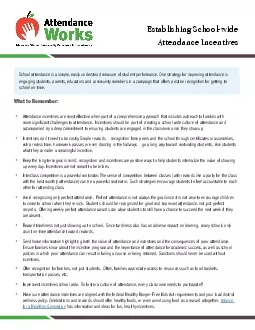

Establishing Schoolwide Attendance Incentives Attendance incentives are most effective when part of a comprehensive approach that includes outreach to families with more significant challenges to att ID: 886470
Download Pdf The PPT/PDF document "School attendance is a simple easily und..." is the property of its rightful owner. Permission is granted to download and print the materials on this web site for personal, non-commercial use only, and to display it on your personal computer provided you do not modify the materials and that you retain all copyright notices contained in the materials. By downloading content from our website, you accept the terms of this agreement.
1 School attendance is a simple, easily un
School attendance is a simple, easily understood measure of student performance. One strategy for improving attendance is engaging students, parents, educators and community members in a campaign that offers positive recognition for getting to school on-time. Establishing School-wide Attendance Incentives Attendance incentives are most effective when part of a comprehensive approach that includes outreach to families with more significant challenges to attendance. Incentives should be part of creating a school-wide culture of attendance and accompanied by a deep commitment to ensuring students are engaged in the classroom once they show up. Incentives don’t need to be costly. Simple rewards – recognition from peers and the school through certificates or assemblies, extra recess time, homework passes or even dancing in the hallways – go a long way toward motivating students. Ask students what they consider a meaningful incentive.Keep the long-term goal in mind: recognition and incentives are positive ways to help students internalize the value of showing up every day. Incentives are not meant to be bribes.Interclass competition is a powerful motivator. The sense of competition between classes (with rewards like a party for the class with the best monthly attendance) can be a powerful motivator. Such strategies encourage students to feel accountable to each other for attending class. Avoid recognizing only perfect attendance. Perfect attendance is not always the goal since it is not wise to encourage children to come to school when they’re sick. Students should be recognized for good and improved attendance, not just perfect records. Offering weekly perfect attendance awards can allow students to still have a chance to succeed the next week if they are absent. Reward timeliness not just showing up to school. Since tardiness also has an adverse impact on learning, many schools only count on-time attendance toward rewards. Send home information highlighting both the value of attendance and incentives and the consequences of poor attendance. Ensure families know about the incentive program and the importance of attendance for academic success, as well as school policies in which poor attendance can result in failing a course or being retained. Sanctions should never be used without incentives. Offer recognition for families, not just students. Often, families appreciate access to resources such as food baskets, transportation passes, etc. Implement incentives school wide. To foster a culture of attendance, every classroom needs to participate!!Make sure attendance incentives are aligned with the federal Healthy Hunger-Free Kids Act requirements and your local district wellness policy
2 . Celebrations and rewards should offer
. Celebrations and rewards should offer healthy foods, or even avoid using food as a reward altogether. for a Healthier Generation has information and ideas for fun, healthy incentives.What to Remember: Positive comments to childrenPositive notes home to parents that appreciate their efforts to get their children to school on timeExtra time at the computer, PE, or recessFree homework passFirst-in-line privileges for lunch or dismissalPencils, pens, stickers, posters, book covers, book marks, etc.Team certificates for the best record or most improved recordName on the “Attendance Wall” in the classroomChance to act as teacher’s assistantRecognition during morning announcementsCertificate/award at student assemblyBreakfast/lunch with the principal, superintendent, school board president, mayor, or local celebritySchool supplies (pencil with logo, or flash drives)Food coupons redeemable in school cafeteriaSmoothie party for class with best attendance“School money” for the school storeChoice of donated products (movie, tickets, gift certificate)Traveling trophy for grade-level homeroom with best monthly attendanceAttendance T-shirts, hats, buttonsAge-appropriate rewards for most improved Parking space near building for student or teacher whose class has most improved attendanceTeachers can offer:Ideas for IncentivesAdministration, PTAs and Student Councils can provide:Good attendance helps kids succeed in school and bolster their self-esteem. Improving attendance requires a comprehensive approach that goes beyond sanctions and includes incentives. Here are some steps schools are taking:When students at a Michigan elementary school achieve perfect attendance for a month, they become a STAR (Studious, Thoughtful Accountable and Respectful) student. They earn a gold T-shirt saying “I am a STAR student.” Their picture is displayed on the television in the school lobby. One California elementary school awards the class with the best attendance an extra 15 minute recess on Fridays supervised by the principal. The students enjoy the attention from their principal and the teacher gets an extra-long lunch break.An Oklahoma elementary school issues “school dollars” to students with good and improved attendance. Students can use the dollars at the school store to buy presents for family.At a Chicago high school, students with good and improved attendance earn special access to the school’s designated VIP lounge.In, Massachusetts, high school students who met attendance goals received free tickets to the homecoming game, simultaneously fostering strong school spirit and a culture of attendance.Attendance Works is a national and state initiative working to www.attendancework.org